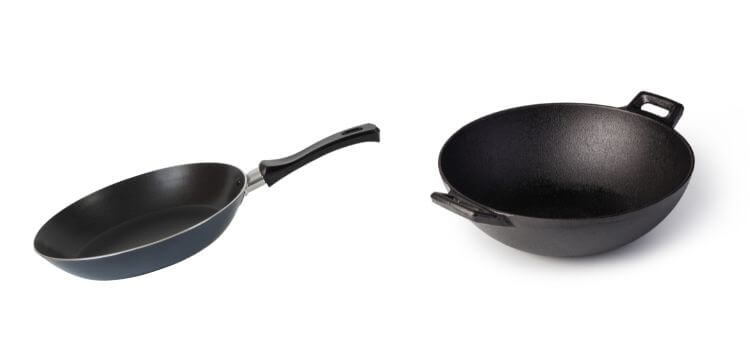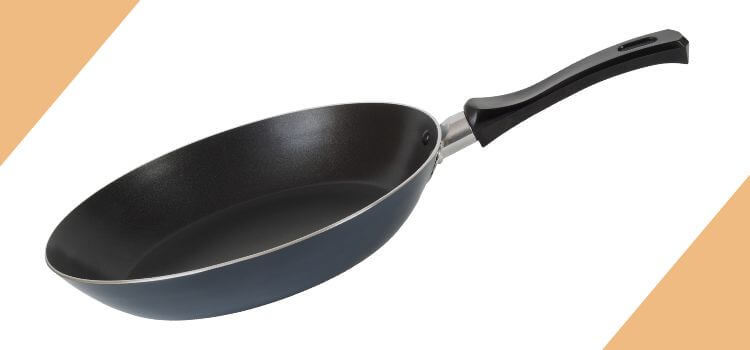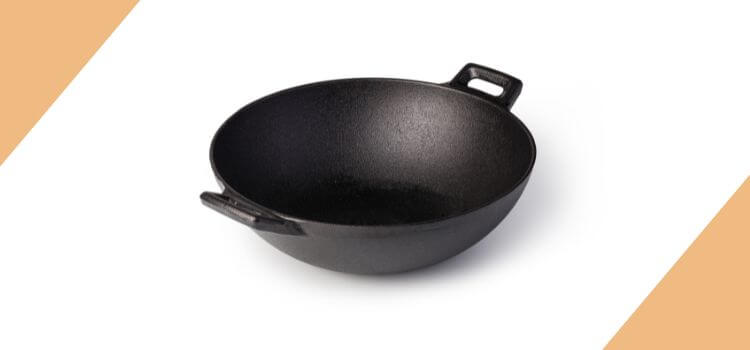As an Amazon Associate, I earn from qualifying purchases

A chef’s pan features sloped sides and a wide flat bottom, while a wok has deep, tapered sides. Both excel in different cooking methods and cuisines.
Choosing between a chef’s pan and a wok depends on your culinary needs. Chef’s pans, also known as sauté pans, offer versatile cooking options, from searing meats to simmering sauces. Their wide base and slightly curved edges provide ample surface area for cooking and easy stirring.
On the other hand, woks are essential for stir-frying due to their deep, concave design, which allows for quick cooking at high temperatures and even heat distribution. The shape of a wok is ideal for tossing ingredients efficiently, essential for authentic Asian dishes. Understanding these kitchen staples will guide you to the right tool for your recipes, whether you aim for perfectly sautéed vegetables or a fiery stir-fry.
Chefs Pan Vs Wok: The Ultimate Cookware Showdown
Chefs pans and woks are popular tools in kitchens. Both have unique shapes. Chef’s pans are versatile, with flat bottoms and sloped sides. This shape is great for sauces and searing meats. Woks have rounded bottoms. They are perfect for stir-frying and steaming. Chef’s pans often come with a lid. Woks typically do not. Woks heat up faster due to their design. Chef’s pans can be used on all stovetops. Woks may need a ring for stability on certain stoves. Both pans require different cooking techniques. Understanding these differences helps cooks choose the right tool.
| Chefs Pan | Wok |
|---|---|
| Flat bottom, sloped sides | Rounded bottom |
| Good for sauces, searing | Great for stir-frying, steaming |
| Often comes with a lid | Usually lidless |
| Suitable for all stovetops | May need ring for some stoves |
Culinary Origins
The chef’s pan has its roots in Western cooking traditions. It is a versatile tool that blends features from a frying pan, saucepan, and skillet. Chefs favor it for its sloped sides and wide base, perfect for sautéing and flipping food easily.
On the other side, the wok hails from ancient China. Its deep, rounded shape makes it ideal for stir-frying, steaming, and deep-frying. The wok’s design ensures even heat distribution, allowing for quick cooking at high temperatures.
Design And Material
The Chef’s Pan is known for its deep sides and flat bottom. It often features a long handle and a wide top. This pan is perfect for sauteing, simmering, and braising. Quality chef’s pans are usually made from stainless steel or non-stick materials. Some may have a layer of copper or aluminum at the bottom for even heat distribution.
Wok Construction is unique. Woks are round-bottomed and designed for high-heat cooking. They are typically made from carbon steel, cast iron, or non-stick materials. The shape allows for easy tossing of ingredients. The materials used ensure quick heating and high temperatures, essential for stir-frying.
Heat Distribution And Retention

Chef’s pans are known for their excellent conductivity. They quickly heat up and cool down. This makes them perfect for precise cooking. The material, often stainless steel or aluminum, spreads the heat evenly. This ensures that food cooks uniformly.
A wok, on the other hand, has unique heating qualities. Its shape allows for high heat in the bottom. The sides get less heat. This is great for stir-frying. Foods can be moved from the bottom to the sides. This way, they stay warm without overcooking.
Versatility In The Kitchen
The Chef’s Pan shines in versatility. It’s great for sautéing, braising, and simmering. Use it to cook stews and soups. It’s also perfect for frying and searing meats. Its design allows for even heat distribution, making every meal perfect.
A Wok is your go-to for stir-frying. But it can do more. Use it to steam, boil, smoke food, and even deep-fry. The high walls help manage large ingredients. It’s ideal for cooking family-sized meals quickly.
Stir Fry Showdown
Stir fry is a quick and healthy cooking method. A chef’s pan often has high, sloping sides. This makes tossing and turning food easy. Yet, it lacks the curved bottom of a wok. Food may not cook as evenly.
Many chefs choose a wok for stir frying. Its unique shape helps heat spread faster and more evenly. This means perfectly cooked veggies and meats. The wok’s design also needs less oil, so meals are healthier. Plus, it’s great for high heat cooking.
Ease Of Handling
Handling the Chef’s Pan is easier for beginners. Its design helps you cook comfortably. You can move it around quickly. It’s perfect for everyday cooking. Foods like sauces and fried eggs work well in it.
Mastering Wok Techniques takes a bit more skill. The wok’s deep shape lets you stir-fry easily. It’s great for cooking at high temperatures. With practice, you can make amazing dishes. Foods like stir-fried vegetables and noodles are perfect for it.
Maintenance And Durability
Maintaining a Chef’s Pan is simpler than one might think. Start by always using wooden or silicone utensils to avoid scratches. After cooking, let it cool before washing. Use mild soap and a soft sponge for cleaning. For tough stains, soaking it in warm, soapy water usually helps. Dry it thoroughly to prevent rust. To keep its surface non-stick, occasionally coat it with a thin layer of oil. This care keeps a Chef’s Pan in top shape for years.
Ensuring the longevity of a Wok also involves straightforward steps. First, season it properly before the first use. This creates a natural non-stick coating. Avoid acidic foods initially to maintain the seasoning. After use, clean with hot water and a soft brush; detergents should be used sparingly. Dry it immediately and apply a light coat of oil to protect the surface. With these tips, a wok can last for decades, becoming better with age.
Price And Accessibility

Investing in a Chef’s Pan can be a smart choice for versatile cooking. Quality Chef’s Pans are usually mid-range priced and widely available. Easy to find both online and in kitchenware stores, they offer great value. Their multi-use design makes them a favored option for many home cooks.
Finding the Right Wok requires consideration of material and build. Traditional carbon steel woks are often less expensive than modern options. Yet, prices can vary based on size, brand, and where you shop. Local Asian markets and online stores are good places to look. For authentic stir-fry experiences, a wok is the go-to choice.
Expert Opinions
Professional chefs have a clear preference for chef’s pans and woks. Chef’s pans are praised for their versatility, ideal for searing, sautéing, and simmering. Woks, on the other hand, are the go-to for high-heat stir-frying. They offer fast cooking with their deep, sloping sides. Chefs love the wok’s ability to create smoky, charred flavors.
Many home cooks also have their favorites. Some adore the chef’s pan for its ease of use and multi-functionality. Others choose the wok for its authentic Asian cuisine. Both are popular in kitchens around the world. Here’s what the cooks say:
| Chef’s Pan | Wok |
|---|---|
| Good for everyday cooking | Best for quick, high-heat dishes |
| Easy to handle and clean | Ideal for stir-fries and tossing food |
| Suits various cooking styles | Requires seasoning and care |
Making The Choice
Chefs Pan and Wok are both popular in kitchens. Choosing one depends on your cooking style. A Chefs Pan is versatile. It’s good for sautéing, frying, and simmering. A Wok is best for high-heat stir-frying. It has deep, sloping sides. This makes it great for quick cooking. The material matters too. Stainless steel pans are durable. They work on all cooktops. Carbon steel woks are traditional. They heat up fast. Yet, they need seasoning to prevent rust. Think about what you cook most. This will guide your choice.
Size and handle type are key too. A small pan or wok suits a solo chef. Large families need bigger sizes. A long handle helps to toss food easily. A helper handle is useful for heavy pans.
The table below shows a quick comparison:
| Chefs Pan | Wok |
|---|---|
| Flat bottom | Round bottom |
| Good for many cooking styles | Best for stir-frying |
| Works on all cooktops | Needs a wok ring on some cooktops |
Frequently Asked Questions
What Is The Main Difference Between A Chef’s Pan And A Wok?
A chef’s pan typically has a flat bottom and rounded sides, ideal for sautéing and searing. A wok, on the other hand, features deep, sloping sides and is designed for stir-frying at high heat. This design difference influences the cooking techniques suitable for each pan.
Can You Use A Wok As A Chef’s Pan?
Yes, but with limitations. A wok can be used for some chef’s pan tasks like sautéing and boiling. However, its deep, curved shape may not be as efficient for tasks requiring even heat distribution across a flat surface, like searing or frying a pancake.
What Are The Benefits Of Cooking With A Chef’s Pan?
Cooking with a chef’s pan offers versatility. Its design is suitable for a wide range of cooking techniques, including sautéing, searing, and simmering. The flat bottom allows for even heat distribution, making it ideal for cooking meats and vegetables to perfection.
How Does A Wok Enhance Asian Cuisine?
A wok’s design is tailored for high-heat, fast-cooking methods typical in Asian cuisine, particularly stir-frying. Its sloping sides allow ingredients to be easily tossed and turned with minimal oil, enhancing flavors and creating a unique texture that’s hard to replicate with other pans.
Conclusion
Deciding between a chef’s pan and a wok hinges on your cooking style. Both offer unique benefits for culinary enthusiasts. A chef’s pan excels in versatile, everyday use, while a wok is unbeatable for high-heat, Asian-inspired dishes. Choose wisely to elevate your kitchen prowess and flavor profiles.
Remember, the right tool can transform your cooking journey.
As an Amazon Associate, I earn from qualifying purchases
Pingback: Fry Pan vs Saute Pan